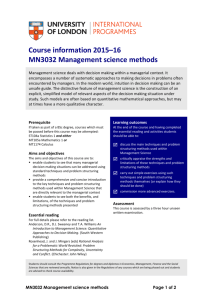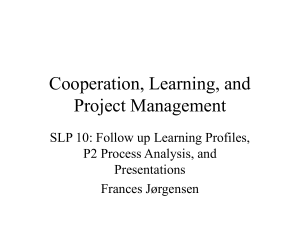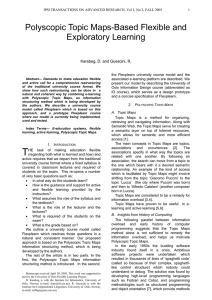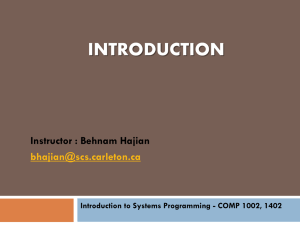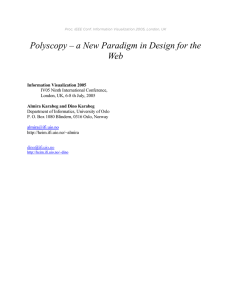Document 11500001
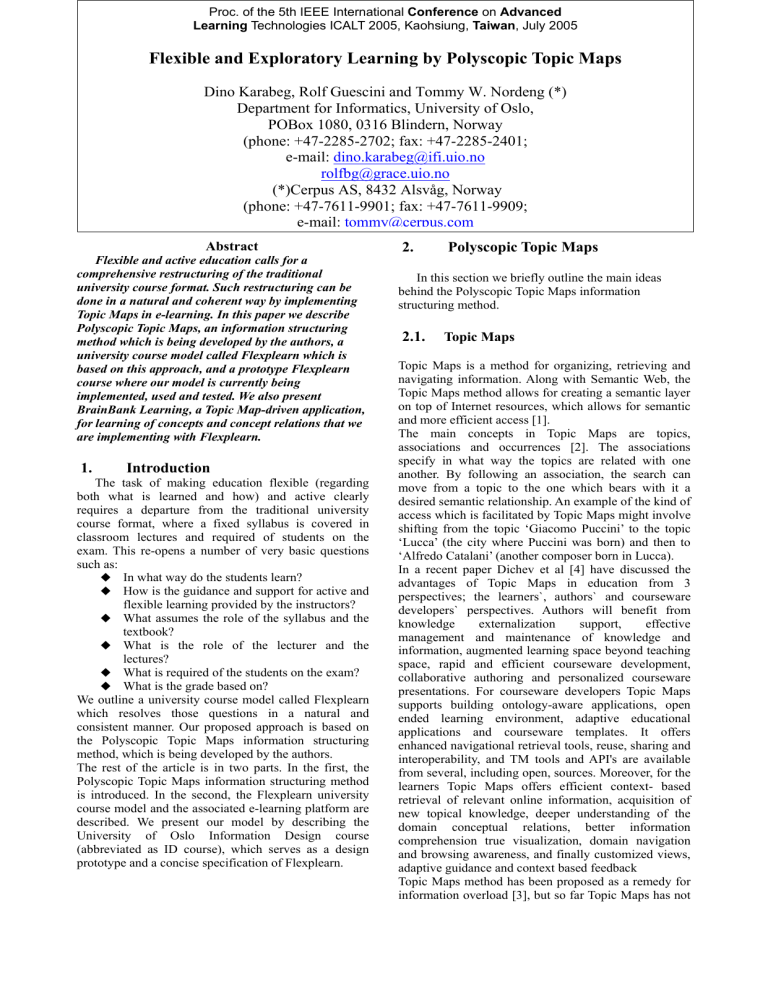
Proc. of the 5th IEEE International Conference on Advanced
Learning Technologies ICALT 2005, Kaohsiung, Taiwan , July 2005
Flexible and Exploratory Learning by Polyscopic Topic Maps
Dino Karabeg, Rolf Guescini and Tommy W. Nordeng (*)
Department for Informatics, University of Oslo,
POBox 1080, 0316 Blindern, Norway
(phone: +47-2285-2702; fax: +47-2285-2401; e-mail: dino.karabeg@ifi.uio.no rolfbg@grace.uio.no
(*)Cerpus AS, 8432 Alsvåg, Norway
(phone: +47-7611-9901; fax: +47-7611-9909; e-mail: tommy@cerpus.com
Abstract
Flexible and active education calls for a comprehensive restructuring of the traditional university course format. Such restructuring can be done in a natural and coherent way by implementing
Topic Maps in e-learning. In this paper we describe
Polyscopic Topic Maps, an information structuring method which is being developed by the authors, a university course model called Flexplearn which is based on this approach, and a prototype Flexplearn course where our model is currently being implemented, used and tested. We also present
BrainBank Learning, a Topic Map-driven application, for learning of concepts and concept relations that we are implementing with Flexplearn.
1.
Introduction
The task of making education flexible (regarding both what is learned and how) and active clearly requires a departure from the traditional university course format, where a fixed syllabus is covered in classroom lectures and required of students on the exam. This re-opens a number of very basic questions such as:
In what way do the students learn?
How is the guidance and support for active and
flexible learning provided by the instructors?
What assumes the role of the syllabus and the textbook?
What is the role of the lecturer and the
lectures?
What is required of the students on the exam?
What is the grade based on?
We outline a university course model called Flexplearn which resolves those questions in a natural and consistent manner. Our proposed approach is based on the Polyscopic Topic Maps information structuring method, which is being developed by the authors.
The rest of the article is in two parts. In the first, the
Polyscopic Topic Maps information structuring method is introduced. In the second, the Flexplearn university course model and the associated e-learning platform are described. We present our model by describing the
University of Oslo Information Design course
(abbreviated as ID course), which serves as a design prototype and a concise specification of Flexplearn.
2.
Polyscopic Topic Maps
In this section we briefly outline the main ideas behind the Polyscopic Topic Maps information structuring method.
2.1.
Topic Maps
Topic Maps is a method for organizing, retrieving and navigating information. Along with Semantic Web, the
Topic Maps method allows for creating a semantic layer on top of Internet resources, which allows for semantic and more efficient access [1].
The main concepts in Topic Maps are topics, associations and occurrences [2]. The associations specify in what way the topics are related with one another. By following an association, the search can move from a topic to the one which bears with it a desired semantic relationship. An example of the kind of access which is facilitated by Topic Maps might involve shifting from the topic ‘Giacomo Puccini’ to the topic
‘Lucca’ (the city where Puccini was born) and then to
‘Alfredo Catalani’ (another composer born in Lucca).
In a recent paper Dichev et al [4] have discussed the advantages of Topic Maps in education from 3 perspectives; the learners`, authors` and courseware developers` perspectives. Authors will benefit from knowledge externalization support, effective management and maintenance of knowledge and information, augmented learning space beyond teaching space, rapid and efficient courseware development, collaborative authoring and personalized courseware presentations. For courseware developers Topic Maps supports building ontology-aware applications, open ended learning environment, adaptive educational applications and courseware templates. It offers enhanced navigational retrieval tools, reuse, sharing and interoperability, and TM tools and API's are available from several, including open, sources. Moreover, for the learners Topic Maps offers efficient context- based retrieval of relevant online information, acquisition of new topical knowledge, deeper understanding of the domain conceptual relations, better information comprehension true visualization, domain navigation and browsing awareness, and finally customized views, adaptive guidance and context based feedback
Topic Maps method has been proposed as a remedy for information overload [3], but so far Topic Maps has not
been utilized extensively for education and learning purposes. The first Topic Maps application for eLearning, BrainBank Learning [5] focused on bottomup learning rather than education whereas TM4L (Topic
Maps for Learning) [6] has been developed a framework supporting the development of ontology-aware repositories of learning materials.
2.2.
Insights from the history of computer programming
The following parallel between information overload and early history of computer programming suggests that the Topic Maps method alone is not sufficient to remedy the information overload, and helps us motivate
Polyscopic Topic Maps. In the early 1950s the budding software industry found itself in a crisis. Ambitious software projects were undertaken which resulted in thousands of lines of ‘spaghetti code’ (called so because of their complex, spaghetti-like control structure) which nobody could understand or debug. The solution was found by developing high-level programming languages such as Fortran and Cobol, and programming methodologies such as structured programming and object orientation [6], which provide methods for creating and structuring easily comprehensible programs.
The conditions around information are now similar. The new information technologies have allowed us to produce unprecedentedly large quantities of information. When we now structure information by using the techniques which were developed for much smaller quantities, chaos results [7,8].
Indeed, the initial version of the World Wide Web has provided hypertext as a tool for modular structuring and hyperlinks as an equivalent to program control. But we presently have no underlying metaphor or principle which would help us structure information into modules in a meaningful and comprehensive way. Furthermore, from the point of view of our parallel, the hyperlinks are the gotos (in the sense that they allow for arbitrary jumps from one context to another), and so are the Topic
Maps associations. The consequence is that the Internet information is currently structured in a spaghetti-like manner, similar to early computer programs.
What is needed is a collection of structuring principles and techniques, analogous to the ones introduced by early programming methodologies. Those are provided by the Polyscopic Modeling information design methodology.
2.3.
Polyscopic structuring of information
Polyscopic Modeling is proposed as prototype information design methodology [9]. Polyscopic structuring of information is one of the key elements in this methodology. In keeping with the basic principle of programming, polyscopic information is structured in terms of small, manageable modules, each representing a simple coherent view, as explained below.
The polyscopic structuring of information is based upon the notion of scope, which may be understood as a viewpoint or a way of looking. Multiple scopes are considered as possible and even necessary. The scopes, and the associated views, can be either high-level or low-level. The high-level views, like the high-level modules in a hierarchically structured program and the view from the top of a mountain, present the large picture. The low-level views present the details. As in a structured computer program, the high-level modules provide the structure for organizing the low-level modules. At the same time, the high-level modules provide the context and the motivation for the information contained in the low-level modules.
Obviously, the polyscopic structuring of information involves more than just reorganizing the existing information. The lacking high-level information needs to be created. The missing low-level information needs to be created and the existing one needs to be reconfigured. The Polyscopic Modeling methodology provides the principles, criteria and methods that are required for this task [10,11].
In addition to vertical abstraction whose goal is to create the high-level information, the methodology also supports vertical abstraction. Polyscopic information is presented in terms of different aspects which intuitively correspond to ‘sides’ or ‘angles of looking’. The aspects may reflect different reader categories, ways of looking at the subject etc.
A high-level view of polyscopic information is given in terms of the Polyscopic Information Ideogram (Figure
1), where the triangle represents a hierarchy of scopes, the circle represents the high-level information and the square represents the low-level information. The message of this ideogram is that polyscopic information
(represented by the ‘i’) consists of a concise and holistic high-level information (the circle or the point) which is founded upon a detailed and analytical low-level information (the square).
Figure 1 : Polyscopic
Information ideogram
The main principles of polyscopic information structuring may be formulated as follows:
Information exists on all levels. Both high-level and low- level views must be provided (vertical abstraction).
Information has multiple aspects, some of which are subtle or hidden. The most relevant aspects must be
provided (horizontal abstraction).
Information is a function of the way of looking or scope. The scope is coherent if it represents a single level of detail and angle of looking (or intuitively, if it reflects a single viewpoint on the metaphorical mountain). Each information module must be associated with a single coherent scope (coherence).
The knowledge of the scope is crucial for proper understanding (intuitively, one must know where on the metaphorical mountain one is standing when looking at a piece of information). Each information module must be associated with a clear and correct representation of the scope (orientation).
The scope determines the view (intuitively, the scope is the control knob given to the reader to switch between views). The reader must given the capacity to select the view by changing the scope (navigation).
To see the naturalness of the polyscopic presentation, it is useful to think of inspecting a hand-held object.
Naturally, one uses the capacity of the hand to turn the object at different angles and take it closer or further from the eye to explore the object. In a similar way, the polyscopic information structuring facilitates the active exploration of the presented subject.
Polyscopic information structuring supports the
‘holistic’ or ‘multiple-perspective’ thinking. This way of thinking is especially relevant in the post-industrial era, where it has become increasingly important that both technical, socio-cultural, political and other aspects of an issue be taken into account in decision making.
In a similar way, the polyscopic structuring of information also supports active, exploratory learning.
2.4.
Making the Topic Maps polyscopic
The Topic Maps provide a natural platform for polyscopic structuring of information. The instance/type and the subclass/superclass constructs allow for vertical abstraction and for implementing the levels. The scoping constructs allow for horizontal abstraction and for implementing the aspects.
As the Topic Map Data Model contains much of the tools needed to implement a Polyscopic presentation of information, one would think that it would be enough to just create a basic Topic Map ontology to implement polyscopy, but there is more to it than that. As some of the Topic Map browser applications like Ontopia's
Omnigator [20] will show us, just presenting the ontology as is, and making it browseable, will eventually create information overload [4] on basis of the amount of associations and scopes that will be available in a topic map. The larger the topic map, the more information will be available for browsing in the ontology, and the more the usefulness of having constructs like scopes and directed associations will diminish. Another problem is also that presenting the ontology as is demands knowledge of the Topic Map data model from the users.[4]
On the other hand, the Polyscopic Modeling methodology provides principles for structuring the
Topic Maps in a polyscopic way. To use again our parallel, the Topic Maps are in the role of a low-level programming language. The goal of Polyscopic Topic
Maps research is to create standard structuring constructs analogous to the do-while loop and the ifthen-else statement. While a systematic account of this research would at this point be premature, for the purpose of our educational model a simple Polyscopic
Topic Map prototype is sufficient. In this prototype, the hierarchy of levels is implemented by providing the taxonomy, which is a hierarchical organization of the main concepts involved (Fig. 2). The Polyscopic
Information Ideogram (Fig. 1) serves for navigating between levels. The aspects reflect the user interests and profiles, ways of looking at the material covered and the kinds of information that is being presented.
We envision it implemented on two levels. One would be on the ontological level, by creating the ontology according to Polyscopic principles (Example. 6). That would involve using associations and scopes explicitly to create the various levels and perspectives needed to create the polyscopic framework. Most of the polyscopic design though, would have to be on the application layer, where one would have to query the
Topic Map ontology to acquire the levels and scopes needed. And then to use means like media of different kinds to implement high level information, and dynamic hyper text and server resources like programming languages and databases to provide and present the low level information
3.
In this section we describe the Flexplearn course model by describing the University of Oslo Information
Design course (INF3210/4210, in further text ‘ID course’), which been developed as a prototype and a test
case of Flexplearn
3.1.
The Flexplearn course model
Subject of study
The subject of study of the ID course is information design, understood as conscious and purposeful use of information and information technology. The course includes a broad spectrum of related themes such as visual literacy and graphic profiling, design software tools such as the Macromedia Dreamweaver and Adobe
Photoshop, motivational issues such as relativism and information overload, philosophical, social and political issues around information creation and use etc. The methodological approach to information, as represented by the Polyscopic Modeling methodology, serves both as the unifying theme and as the source of guidelines. It is not difficult to understand the need for this type of course. Academic communication cannot remain restricted to books, articles and other traditional
Oslo’s Flexible Learning Project.
presentation formats. Students need to learn how to use the new media technology. But even if one wants no more than to learn how to create Web pages, proficiency with Web design software will not be sufficient. To be able to communicate in a new way and to truly exploit advantages of the new medium, one needs to look more deeply into the very nature of communication, learn about various elements of visual information such as the colors and the fonts, learn about information structuring and navigation etc.
Furthermore, in the Age of Information students also need to learn about such issues as our changing information needs, subtle psychological and cultural effects of information and how information is related to economic and political power.
The methodological approach to information further leads to the creation of new methods for stating and proving research results [13]. Exposure to the methodological approach can help the researcher in a traditional field broaden the repertoire of themes and methods, and the researcher in a new inter-disciplinary field develop the required methodological framework. a discussion forum are provided. Other tools are being designed and experimented with.
Whenever possible, the learning resources are made available online. A resource is made available by
‘placing it on the (ID course Polyscopic Topic) map’.
The course Polyscopic Topic Map is where all the online learning resources can be found. (Fig. 2)
An example of a learning resource may be a guest lecture about Topic Maps which discusses the information overload as motivation. This lecture is videotaped and placed on the map as a topic. Suitable associations with ‘standards and markups’ in ‘tools’, and with ‘information overload’ in ‘issues’, are added to this topic. The Topic Maps lecture can then be accessed both by scanning through the ‘lectures’ aspect of the map and by following the associations from any of the associated topics. In this way the student who may be interested in, say, the information overload, can easily access all the learning resources that are associated with that topic. (Fig.3)
3.2.
The student population of the ID course is highly diverse. At present the course has about 120 enrolled students representing a broad range of backgrounds and interests. The students are in part computer science majors (that being the department where the course is taught) and in part majors in a variety of departments around the University of Oslo campus. Some of the students are working full time. The course can be taken both on the undergraduate and the graduate level. We are also planning to extend the course internationally.
This diversity of student situations, backgrounds and interests further strengthens the motivation for our flexible learning approach.
3.3.
Students
A flexible learning environment
The notion of a flexible learning environment is central to the Flexplearn model. The purpose of a learning environment is to provide a variety of learning resources, and a rich and inspiring environment in which learning happens in a number of ways, not the least by actively exploring a certain theme or themes of interest.
The flexibility is both with respect to the time and place of learning (a sufficient part of this environment is available online to make this feasible), and with respect to what is learned (the students learn according to their own needs and interests).
The ID course provides a flexible learning environment for studying information design. Students learn from one another, from the instructors and from the online and other resources. The main role of the class instructor is to set up and coordinate the flexible learning environment. Standard tools such as a Wiki and
3.4.
The Polyscopic Topic Map Application, does it work as intended?
That is a question which is to early to answer fully at this point, since the course did not manage to have the student use the Polyscopic Topic Map application extensively this semester (Spring 2005). But with background in the project done with BBL [5], where 14year old students were given the possibility of recording their learning by using Topic Maps, we expect at least the same positive outcome for students at the university level as the BBL project showed for the 14-year olds.
Evaluations made by students in this year's course at the
ID course at the Department of Informatics, University of Oslo, shows that the students that got to work with their learning through topic maps, found them very helpful in organizing their thoughts and findings while studying the course topics.
As we see it, only having the possibility of recording your acquired knowledge in an ontology, and then being able to browse it in a format that relies on hyperlinks, which allows for arbitrary jumps out of context does not necessarily lead to better learning, it may rather lead to informational or cognitive overload. [21] Of course, the
Topic Maps themselves solve some of these problems through the possibility of having n-ary associations, which create a sense of common context between two subjects, or the possibility of organizing information within the concepts of type / instance. These are good organizing principles, but there is still the question of presentation that has to be solved, and as the ID course
Polyscopic Topic Map application tries to solve some of the tasks through designing the topic mapped information according to polyscopic principles, it is still very much in the process of being designed.
Still the application needs to have more high level information designed, utilizing the topic maps features to their full extent to implement polyscopy, allowing the students to browse the information in manageable
levels, leaving it up to the student to browse herself into an increasing (or decreasing) extent of detail. Another task to solve is to give the student the opportunity to present her acquired knowledge in several perspectives, implementing the horizontal dimension of polyscopy, reflecting the different ways one might want to look upon a course subject.
The next time the course is running, the ID course
Polyscopic Topic Map application will have matured more, and the presentation of subjects and concepts for the course will be organized further according to polyscopic principles for information design. This time the Polyscopic Topic Map application will be integrated further into the course, and we will have more insight into what degree the polyscopicly designed Topic Map will help the students in their learning.
3.5.
Plans for further development of the
Polyscopic Topic Map Application
From the success of the BBL project, and also the beginnings of the Polyscopic Topic Map application, we want to take it to the next level, that being the creation of polyscopicly designed learning objects., and a polyscopicly designed authoring tool common to both learners and courseware developers, seen as an advantage in the design of educational components [22].
Although It is still very premature to go into any detail, but we see topic maps and polyscopy as good models for the creation of these objects. The use of Topic Maps themselves offer several advantages in the creation of objects and interfaces for both learners, courseware authors , and software developers [4], such as effective management and maintenance of knowledge and information, better context sensitive retrieval of information, and the possibility of effective courseware development.
Having learning objects built on Topic Maps, also gives us the possibility of letting the student manipulate her learning s through interaction, gradually creating and combining learning objects through associations. This often leads to unexpected insights, as observed by Steve
Pepper while building his Opera Topic Map [23], something that might be very useful to the student.
Having such a system also supports a constructivistic approach to learning by making it possible to learn through engaged inquiry, something that is valued highly by educators [22].
3.6.
The course as a design project
A salient characteristic of the ID course Flexplearn environment is that the students learn (in part) by codesigning this environment. In the ID course the students learn information design by designing the ID course and the course materials.
The course instructor has the role of the head designer, facilitating and coordinating the individual projects.
The students organize themselves into one to four person groups with the task of doing term projects. The
ID course Polyscopic Topic Map serves as a platform for orchestrating the project work.
The students are told that, when organizing their project groups, they are in a similar position as the globe explorers five centuries ago. The ID course Topic Map reflects the current status of our knowledge about information design (‘the world as we know it’). The students’ task is to organize an ‘expedition’, venture into a part of the ‘map’ of their choice, explore it and bring back knowledge and resources. Based on everyone’s findings, we supplement, refine and recreate the map for the next generation of students.
Naturally, the ID course Polyscopic Topic Map provides also the ‘containers’ for the knowledge and the resources resulting from the student ‘expeditions’. At the beginning of the term each student obtains a personal map, which is then used for keeping track of the ‘itinerary’ and for placing the resources (books and articles, online tutorials, insights etc.). (Fig 4 & 5)
The goal of each group project is to create a polyscopic presentation of the explored topic area. A student group might, for example, take a theme which is as technical as the Adobe Photoshop, about which a lot has already been written and available also online. The group would still be able to do creative and useful work by:
Creating a brief high-level presentation of
Photoshop. The main goal is to present
Photoshop to the students in the course so efficiently that within minutes of reading one is able to understand what Photoshop is all about and what tasks it may be good for.
Organizing the best available resources (texts, tutorials, examples etc.) as low-level data. Here the goal is to select and organize the available learning resources and provide efficient and easy access to those resources.
Learning and using the state-of-the-art information design tools to accomplish the task. Often the students will use Flash, XML and other tools and techniques to create the high-level view and to structure information and implement the navigation. In this way the students are given an opportunity to learn the technical tools and to use them in the information design way.
By participating in projects, the students learn information design in two ways: by exploring a theme which is of interest for information design, and by presenting this theme by using information design methods and tools.
The result of each student ‘expedition’ is a project website and its documentation. In addition, each student produces a personal report.
3.7.
Assessment
Educational practices are changing from being predominantly teacher-led to largely student-centered.
But how can the students themselves be able to assess their position relative to a future learning environments consisting of a diverse set of learning activities from which learners somehow may take their pick? The learner’s history and goals define an entry position relative to the learning activities. A different entry position is likely to result in a different partition of the set of available activities in activities to skip and to complete. Different entry points will thus result in different paths through the set of relevant learning activities. Computer supported positioning in learning networks could contribute to the formidable set of hurdles that arises in such a scenario. In fact, it assumes answers on a substantial number of the research questions that were recently proposed for intelligent information systems [13]. In this article we focus on how the learner’s history can be recorded and stored in electronic portfolios.
Electronic portfolios have traditionally been defined as an organized collection of digital and/or analog artifacts and reflective statements that demonstrate growth over time [14]. In a broader perspective e-portfolio has been defined as a tool that can provide sophisticated control of one’s virtual identity [15]. A fundamental characteristics of an e-portfolio in this perspective is that the virtual identity is stored using a common set of functional and organizational standards. Wilbert Kraan puts it this way: “Without the means to output eportfolio data in a standard format, it's next to useless”
[16].
Successful learning often takes place within a sociocultural context where an interaction between humans is essential [17]. The ability to work in projects, where peers have equal access to all project resources is one attractive way of doing this. The project members should be able to share resources from their “personal” topic maps with the project, as well as accept the project resources and import them into their maps. Moreover, learners should be able to share knowledge maps and resources with the world by publishing them on public searchable web pages, free for anyone to browse. It is expected that this may help exchange of knowledge between peers. It is also important for the interaction between learner and teacher to have the ability to share resources. The teacher needs to be able to transmit resources to the learners. This could be possible in several ways, but as a principle, the learner should have to actively accept new resources. This is to ensure that the learner always is actively aware that he has received something new that can be used in his own knowledge structure. Furthermore, teachers should be able to share learning resources, from complete ontologies to simple learning objects, so that developed learning resources could be reused not only by the developer, but also colleagues and other teachers. Research data indicates that the learners need curriculum and ontological support to responsibly record and manage their eportfolios [15].
3.8.
Grading
Two kinds of lectures are provided: classroom lectures and group lectures. The classroom lectures are focused on the basics of information design, the material which may constitute the academic core of the subject. The group lectures are intended to provide support for project work. They give a systematic overview of information design tools and techniques.
The classroom lectures are taught by the class instructor and guest lecturers. They cover such themes as ‘tackling the information overload’, ‘Information, Not
Manipulation’ and ‘Creation of Meaning’. The guest lecturers represent a broad variety of backgrounds and vocations. The group lectures are taught by teaching assistants.
A fraction of the group meetings, during the more advanced stages of project development, are reserved for hands-on help. The students bring their home computers or use the ones available in class, show their projects and ask questions. The teaching assistants walk around and give help and advice. The student’s personal itinerary through the ID course Topic Map allows us to tailor the grade to the student’s own learning path and depart from a fixed syllabus.
As a rule of thumb, the grade in the class reflects 50% what the student has taught others (by participating in the project and in other ways) and 50% what the student has learned from others.
3.9.
Exams
Presently, the course has a small take-home midterm and a combined take-home and oral final exam. We are planning to experiment with other evaluation forms, including more frequent online ones.
The midterm task is to set up the project team and theme and describe the itinerary for the personal and team journey. Each student draws her personal itinerary on the ID course Topic Map and describes the milestones and the personal interests and goals. One of the effects of this midterm is that the students become familiar with the Topic Maps and with the ID course
Topic Map.
The individual take-home final is limited to four pages of text. The student answers several fundamental questions about information design, and further questions reflecting her participation in the group project. Before the oral exam, the instructor and the teaching assistants examine the group projects and individual take-home exams, make comments and give tentative grades.
The members of each group take the oral exam together.
The exam consists of a ten-minute project presentation, followed by questions addressed to individual students, which are based on the students personal itinerary through the ID course Topic Map.
4.
Concluding remarks
What has been said about Polyscopic Topic Maps and about our Flexplearn course model allows us to discuss the advantages that Polyscopic Topic Maps offer when used as basis for flexible and exploratory learning.
To see the usefulness of Topic Maps in this context, it is sufficient to draw conclusions from our parallel: If the student should be allowed to depart from habitual learning paths and explore new terrains by following his own needs and interests, what could be more natural than to provide a good, reliable map as support for such journey? As we have seen, such map can also allow the student to present the trajectory and the results of her explorations, and the instructor to organize a customized exam.
The question remains, why should the Topic Maps for flexible and exploratory learning be polyscopic? There are several ways to answer this question. One of them follows directly from our parallel: The geographical maps are polyscopic. They have levels (of detail or granularity), each serving a different purpose. They also have aspects: physical, political, climatological and others. For very similar reasons, the guidelines for flexible and exploratory learning also need to be presented polyscopically. The high-level view, like the coarse-scale map or the view from the top of the mountain, provides an overview and allows the student to choose the general direction. The low-level views provide more concrete guidelines in terms of learning resources. The aspects serve a similar end as in the geographical maps, namely for distinguishing between various usages and different kinds of information presented.
Another reason for using Polyscopic Topic Maps is that this allows us to take care of the prerequisites. While learning no longer follows a linear path, which would naturally allow for presenting the material in the order required, it now follows a path in the graph beginning from the root, which can still have the same property. It is natural to present the foundations and general insights as high-level views, and of the material for more indepth study as low-level view. When the learning resources are placed in a hierarchical taxonomy, as it is in the ID class Topic Map, then the students can easily orient themselves by first learning the parent nodes and then the low-level ones. This further supports learning at the right level of generality, which is efficient.
Polyscopic Topic Maps support good thinking and learning habits. The levels allow us distinguish what is fundamental from what is ephemeral, the large picture from the detail. The aspects allow us to control the complexity by distinguishing between different angles of looking (technical, humanistic, philosophical etc.) while still keeping them together.
The Polyscopic Topic Maps are particularly suitable for multi-disciplinarity, inter-disciplinarity and transdisciplinarity learning and research. They allow for overcoming the separation between the humanistic and the technical aspects of an issue, which needs to be encouraged [18].
During the brief history of e-learning, the systems which are relatively straight-forward online implementations of the conventional class model have been received in practice with varying degrees of success. Our Flexplearn course model is a result of a different approach where a completely new learning model is developed, which on the one hand exploits the advantages of the available technology, and on the other hand employs the known principles of good learning.
The still limited practical experience with the
Flexplearn suggests that this might indeed be an approach to e-learning which ‘works’. The approach taken in the development of Flexplearn can be generalized and applied to other tasks [19].
Our final remark is about the Flexplearn approach as a course development strategy. Initial experience suggests that Flexplearn may provide a productive and inspiring flexible learning environment also for a large number of enrolled students. Economies of scale can then warrant the use of additional resources, inviting international speakers, investment into state-of-the-art communication design etc., which would then further increase the chances of creating a productive and inspiring flexible learning environment.
5.
References
[1] ISO 13250.
http://www.isotopicmaps.org/rm4tm/
[2] S. Pepper, The TAO of Topic Maps.
http://www.ontopia.net/topicmaps/material s/tao.html
[3] L. M. Garshol, What are Topic Maps?
http://www.xml.com/pub/a/2002/09/11/top icmaps.html
).
[4] C. Dichev, D. Dicheva and L. Aroyo, Using Topic Maps for web-based education. Int. J. of Advanced Technology for Learning, Vol. 1, No 1, 2004, 1-7.
[5] S. Lavik and T. Nordeng, BrainBank Learning - building personal topic maps as a strategy for learning. XML
Europe 2004. Amsterdam, April 2004.
[6] Dicheva D, Dichev, C, Sun, Y & Nao, S 2004. Authoring
Topic Maps-based Digital Course Libraries. Retrieved
12/8, 2004, from
http://wwwis.win.tue.nl/SW-
EL04/AH-SWEL-Camera-ready/SWEL04-
AH-PDF/%2311-Dicheva-Dichev-SWEL-
AH.pdf
[7] O. Dahl, E. Dijkstra, C. Hoare, Structured Programming .
Academic Press, 1972.
[8] P. Lyman et al., How Much Information 2003.
http://www.sims.berkeley.edu/research/pro jects/how-much-info-2003/
[9] R.S. Wurman, Information Anxiety 2. QUE, 2001.
[10] N. Postman, Informing Ourselves To Death. Keynote speech at German Informatics Society conference,
Stuttgart, October 11, 1990.
[11] D. Karabeg, Designing Information Design . Information
Design Journal, vol. 11(1), Fall 2003.
[12] D. Karabeg, Polyscopic Modeling Definition . In Griffin at al (Ed.): The Turning of the Tide. Selected Readings of the IVLA, 2004.
[13] Cherniavsky JC & Soloway, E 2002. A survey of research questions for intelligent information systems in education. Journal of Intelligent Information Systems 18:
5-14
[14] Barrett HC 2001. Electronic Portfolios, from
http://electronicportfolios.com/portfolios/e ncyclopediaentry.htm
[15] Treuer P & Jenson, JD 2003. Electronic Portfolios Need
Standards to Thrive. Educause Quarterly 2: 34-42
[16] Kraan W 2003. The Open Source Portfolio Initiative releases 1.0, from
http://www.cetis.ac.uk/content/200308201
53519
[17] Vygotsky LS 1978. Mind in Society. Cambridge, MA:
Harvard University Press.
[18] H. A. Linstone, Decision Making for Technology
Executives.
Artech, 1999.
[19] D. Karabeg, Design Is The Alternative to Tradition . Proc.
EAD6 conference, Bremmen, March 2005.
[20] The Omnigator:
http://www.ontopia.net/omnigator/models/i ndex.jsp
[21] M. Jacobson, C. Maouri P. Mishra, & C. Kolar, Learning with hypertext learning environments, Journal of
Educational Multimedia & Hypermedia, 5(3/4), 1996,
239-281
[22] Roschelle, J., DiGiano, C., Koutlis, M., Repenning, A.,
Jackiw, N., & Suthers, D. (1999). Developing educational software components . IEEE Computer,
32(9), 50-58.
[23] The Ontopia Omnigator : Cruising the Knowledge Web http://www.ontopia.net/omnigator/docs/navigator/usergui de.html#d0e526
Figure 2 : Course Polyscopic Topic Map
Figure 3 : Flexplearn TopicMap application : View of Lecture with resources
Figure 4 : The Flexplearn application prototype, itinerary editing interface.
Figure 5 : The Flexplearn application prototype, association editing interface.
<association>
<instanceOf>
</instanceOf>
<member>
<roleSpec>
</roleSpec>
</member>
<member>
<roleSpec>
</roleSpec>
</member>
</association>
<association>
<instanceOf>
</instanceOf>
<member>
<roleSpec>
</roleSpec>
</member>
<member>
<roleSpec>
</roleSpec>
</member>
</association>
Example 6 : Trivial XTM fragment example of what could be polyscopicly designed associations
